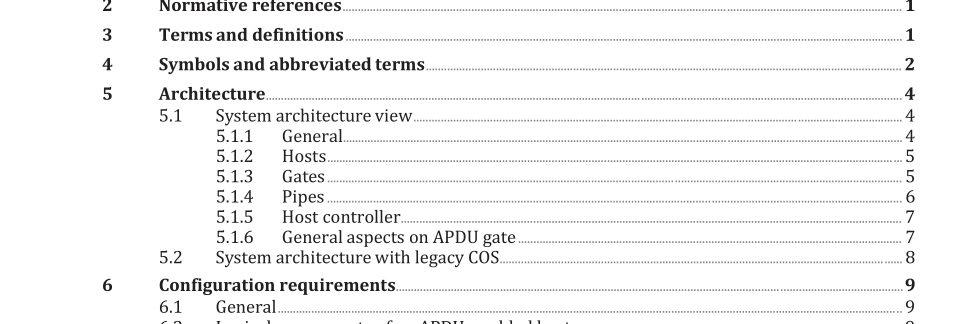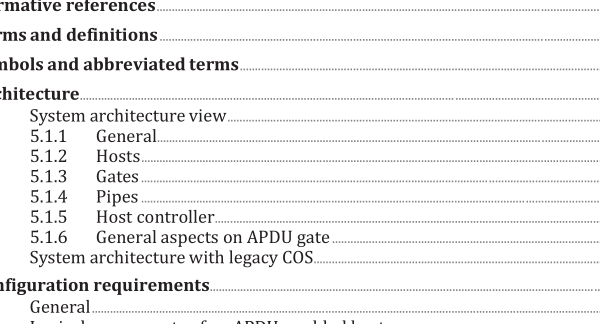ISO IEC TS 22924:2021 pdf download – Identification cards — Transport layer topologies — Configuration for HCI/ HCP interchange.
1 Scope This document specifies the requirements for a protocol derived from HCI/HCP (see ETSI TS 102 622) enabling communication for devices regardless of data link and physical layers. This document covers the following: a) outline of a system comprised of one or more hosts and one controller; b) extension of connection topology between hosts and host controller (i.e. star topology and additional other topologies); c) segregation between existing system using ETSI TS 102 613 and new system compliant to this document (this document refers ETSI TS 102 613, but does not change its specification and does not use RFU). For ETSI TS 102 622, data link layer and physical layer like SWP specified in ETSI TS 102 613 is out of the scope. Albeit questioned in this document, the duplication of OSI transport layer by e.g. enforcing encapsulation of HCP into T=1 or the reverse, is out of the scope. 2 Normative references The following documents are referred to in the text in such a way that some or all of their content constitutes requirements of this document. For dated references, only the edition cited applies. For undated references, the latest edition of the referenced document (including any amendments) applies. ISO/IEC 7816-3, Identification cards — Integrated circuit cards — Part 3: Cards with contacts — Electrical interface and transmission protocols ISO/IEC 7816-4, Identification cards — Integrated circuit cards — Part 4: Organization, security and commands for interchange 3 Terms and definitions For the purposes of this document, the following terms and definitions apply. ISO and IEC maintain terminological databases for use in standardization at the following addresses: — ISO Online browsing platform: available at https://www.iso .org/obp — IEC Electropedia: available at http://www.electropedia .org/ 3.1 APDU gate entry point to a service processing command APDU inside a host ( 3.6 ) or returning response APDU 3.2 APDU application gate entry point to a service sending command APDU and retrieving correspondent response APDU
The generic term “host” is used to refer to any host (e.g. terminal host, UICC host) excluding the host controller. The dynamically allocated range of values shall be used by the host controller to assign a HID to any host not identified in Table 1. The host controller shall always assign the same HID to a given host throughout different sessions as long as there is no modification in the hardware configuration of the device. NOTE 1 NOTE 2 In ETSI TS 102 622, there is no statement that a HID has to be unique. ETSI TS 102 622 does not describe how a host controller assigns an HID to a host. 5.1.3 Gates This subclause contains a subset of information from ETSI TS 102 622 about gates. A gate provides an entry point to a service that is operated inside a host. The HCP enables gates from different hosts to exchange messages. There are two types of gates: — management gates that are needed for the management of the host network; — generic gates that are not related to the management of the host network.
ISO IEC TS 22924:2021 pdf download – Identification cards — Transport layer topologies — Configuration for HCI/ HCP interchange






